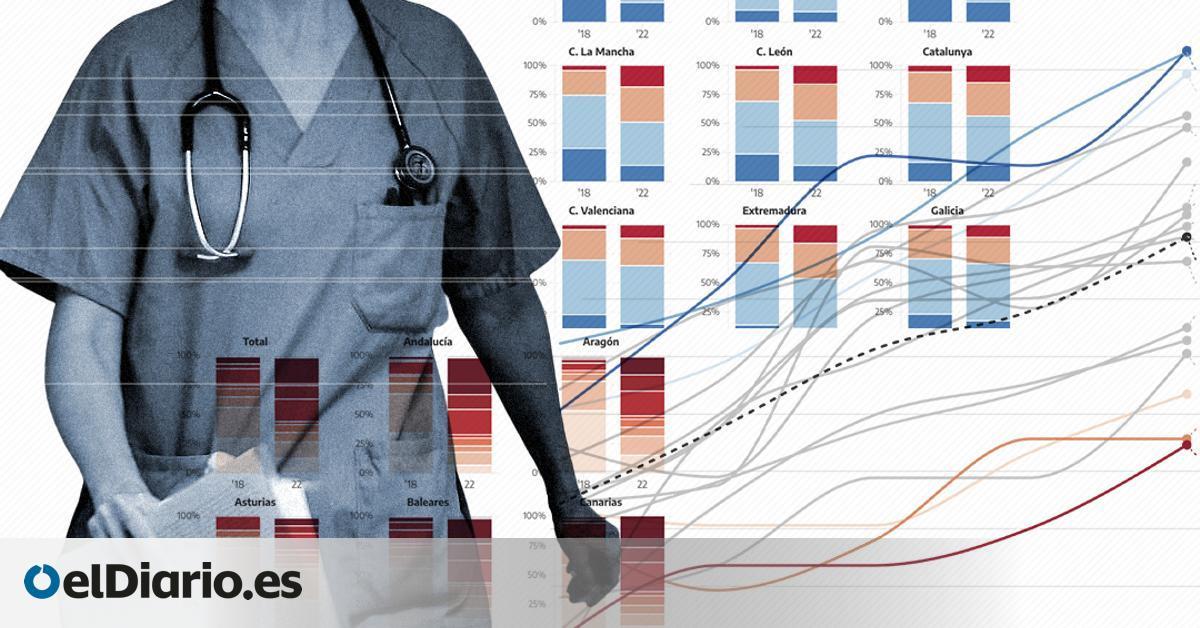
The Spanish population is concerned about health. Professionals have spent decades warning of the shortcomings of a system that was overwhelmed by the pandemic. Waiting lists, saturated agendas, burned workers and a transfer to the private sector are the background to one of the data provided by the latest CIS barometer, published a few days ago: 22.9% of respondents are “personally” affected by the healthcare crisis. It is not a minor number. If it is extrapolated to the citizenry as a whole, the total is close to 11 million individuals.
A year and a half on the waiting list for a hip replacement or an MRI: “Waiting for the appointment is dying sooner”
Further
Five days before the elections, it is clear that healthcare, or attempts to remove it from the conversation, are on the parties’ agenda. The result of the polls on Sunday will be the governments that will manage the system for the next four years in a dozen autonomous communities, where half of the population lives. The Prime Minister himself, Pedro Sánchez, announced last Saturday an investment of 580 million euros in primary care, included in a package of 1,000 million in the General State Budget.
On the same day, the president of the Community of Madrid, and also a symbolic candidate in the municipal councils of Bilbao, attended an event in Euskadi to revive the memory of ETA and request the banning of Bildu, against the criteria of the president of the PP, Alberto Núñez Feijóo. Despite the fact that health care has been where Isabel Díaz Ayuso has found the most opposition, all the polls bring her closer to an absolute majority in the Assembly.
“For voters to decide their vote based on an issue, it is important that they are clear about how a different candidate is going to generate a different dynamic. The left has made efforts in this sense and there are voters who are clear about it, but it is possible that they have not been able to send the message that they are going to apply a very different health policy and that some voters do not quite perceive that health is going to depend of their vote”, explains the doctor in Political Science and expert in electoral behavior Berta Barbet.
a turning point
The last four years, which mark a full legislature, have been a turning point for the National Health System. “In 2019, the health system as a whole had not yet recovered from the cuts of the previous crisis, it was weakened and the pandemic totally overwhelmed it, with public health that was maintained on the efforts of health workers,” explains the spokesperson. from the Federation of Associations in Defense of Public Health (FADSP), Marciano Sánchez Bayle.
With the consequences of the health crisis still kicking in, health professionals lit the fuse for the demands that had been dragging on for years in various autonomous communities. The gasoline for these claims was supplied by the citizens of Madrid, who took to the streets in two massive demonstrations in the last year. On November 13, 2022, hundreds of thousands of people mobilized to defend quality public healthcare in the Community. The germ was the obvious deterioration of Primary Care, which erodes the entire structure of the system. The protest was replicated in February.
As can be seen in the following graph, prepared by elDiario.es with data from the health barometers of 2018 –prior to the last regional and municipal elections of similar weight– and of 2022, accessibility to this first healthcare step has seriously deteriorated in these four years. On average, citizens say that the wait is twice as long as a legislature does.
By community, none have been able to reduce the wait, but some have disrupted the list more than others. Andalusia, the Canary Islands, the Valencian Community and Madrid have added more than five days to what was already expected in 2018. In the case of Catalonia, where there have also been strikes in recent months, the delay in being seen by the family doctor increased up to 11.6 days on average. In general, it is common for the socks to be fattened in neighborhoods where the socioeconomic level of the population is lower, compared to those where other systems are accessible, explained the technical secretary of Primary Care of the State Confederation of Medical Unions, Ana Giménez, in this report.
Beyond the average, the table shown below shows, community by community, the percentage of the population that received care in 2018 from the time they requested an appointment with their family doctor until they were finally seen, compared to what that was indicated in 2022. If five years ago 29.4% were attended in the first two days and 56% in the first three, this figure has fallen to 26.4%. On the contrary, the upper part of the graph darkens because if 6% of patients used to take 11 days or more to access a consultation, today they are 23.6%.
How much worse have the Primary Care waiting lists in each CCAA?
Comparison of the % of patients who had to wait more than one day from the time they made an appointment until they were seen by the family doctor because there was no appointment available before, in 2018 and in 2022, by autonomous community
Source: CIS
The dynamic in this sense is repeated in all communities, and all are far from the commitment acquired with the Ministry of Health in the Strategic Framework for Primary and Community Care, approved in April 2019, to “guarantee that the demand for care does not urgent is attended in less than 48 hours” in the short term. Those that come closest are Navarra, Asturias and Euskadi, whose Primary Schools serve half of the people who need it in the first three days. Specifically, 56.7%, 55% and 47.3%, respectively.
Precisely, these communities are, together with Extremadura, the ones that have budgeted the most money for health in 2023, according to data from the FADSP. They are the only ones that exceed 2,000 euros per inhabitant, raise the national average of 1,809 euros per citizen and bury Madrid (1,446 euros), Catalonia (1,456) and Murcia (1,535) in the table. With the exception of Euskadi and Catalonia, which do not hold regional elections this Sunday, in the communities that invest the most they hope to revalidate socialist governments, while those that allocate less money to health do the same with Partido Popular governments.
Investing more or less in health, explains Sánchez Bayle, is “a political decision of the governments or the assemblies of each community and their greatest concern for the public health system.” “In the case of Madrid, it is clear that, since the time of (President Esperanza) Aguirre, there has been an interest in dismantling and decapitalizing the public health system to favor the private sector. It cannot be said that it has not been successful, because it is the community with the highest percentage of population with private insurance”, indicates the doctor.
It is in Madrid where citizens spend the most money directly out of their own pocket on private healthcare. In 2022, each person from Madrid allocated an average of 936 euros to private insurance, followed by 816 euros in Catalonia and 813 in La Rioja, according to the report. Private healthcare, adding value 2023from the IDIS Foundation, which brings together the sector.
Not only that: indirectly, through taxes, the Community chaired by Isabel Díaz Ayuso, is also the one that finances the private sector the most through concerts, together with Catalonia, with a long tradition in this formula. According to the report Health services of the CCAA, accounted for 11.7% and 23.9% of budgeted spending. But one thing is the budget and another the expense. The Madrid Health Service presented the annual accounts for 2022 last Friday, which show an 82% year-on-year increase in concerts and contracts with companies related to health, according to the complaint of Comisiones Obreras.
The president of the Collegiate Medical Organization, Tomás Cobo, warns that “the increase in private insurance can lead to poor public health for the poor.” In a recent interview with elDiario.es, he pointed out that the public health system had three bankruptcies: the primary care that the figures show; that of public coverage, which is reflected in the increase in insurance; and the job insecurity of health personnel, who have taken to the streets in Madrid, Andalusia, Extremadura, Catalonia, Cantabria, Valencia, Murcia, Navarra, Asturias or the Basque Country, where two days of strikes have been held on May 18 and 19 .
Waiting lists for the specialist
The CIS barometer also asks about the waiting time to be seen by a specialist. In this case, there has been a change in the way of grouping the answers that prevents the differences from being clearly seen: in 2018 those who said they had taken up to 3, 4, 5 and 6 months and more than half a year were differentiated; in 2022, it included those who took more than three months in the same group, so it cannot be assessed whether or not the wait times for the highest sections are reduced.
This has increased the wait for the specialist in each community
Comparison of the % of patients who had to be seen by a specialist doctor, according to the waiting time, in 2018 and in 2022, by autonomous community
Source: CIS
Despite everything, there are striking data, such as the average increase from 25.3% to 37.7% who affirm that they waited more than three months to see a specialist. Or that of La Rioja, which went from 17.6% to 51.7%. It is together with Extremadura, Castilla-La Mancha and the Canary Islands where half of the patients who need one of these visits wait more than a quarter to be seen.
The data used in this information shows the answers that citizens give to the CIS. Those provided by the autonomous communities, which are the official ones, do not always show the reality behind the numbers. First, because the waits are cumulative. But, above all, because each department uses its own criteria, when not cheats, to start counting. In his last annual report, from 2022, the Ombudsman noted a “remarkable” increase in complaints received due to delays in receiving care “in external consultations, diagnostic tests and surgical interventions”
The OECD has also warned of other weaknesses in the Spanish health system, such as hospital beds per 1,000 inhabitants, well below the European average in Spain. If in the EU as a whole this is in the five places per thousand citizens, in Spain it barely reached three in 2020.
With these ingredients, it is not uncommon for the population’s perception of health to have worsened in the last four years. Now only 14% of the population believe that the public system “in general, works quite well”. In no community do more people grant it that status now than in 2018. At the other extreme, people who respond that the system “is so bad that it would need to be redone” have tripled.
As the following graph shows, the worst assessment has risen 10 points or more in a dozen communities: Andalucía, Aragón, Canarias, Castilla y León, Castilla-La Mancha, Extremadura, Madrid, Murcia, Euskadi and La Rioja.
The assessment of the functioning of the health system worsens
Comparison of the % response to the question “Which option best expresses your opinion about the functioning of the health system in our country?” in 2018 and in 2022, by autonomous community
Source: CIS
Source: www.eldiario.es

